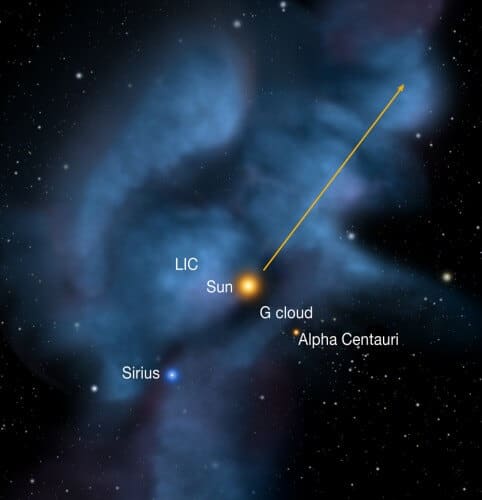Scientists who examined the data of a new spacecraft, which like some of its predecessors examines the cosmic radiation, discovered to their surprise that the direction of the radiation has changed in the last 40 years, probably due to changes in the interstellar cloud in the region where the solar system passes

Avi Blizovsky
Scientists involved in NASA's IBEX (Interstellar Boundary Explorer) mission that studies the boundary between the solar system and interstellar space have discovered that the particles flowing into the solar system from interstellar space have changed their direction over the past forty years.
The find helps scientists map our location within the Milky Way galaxy, and is essential to understanding our place in the universe along the vast scale of time - where we came from, where we are now, and where we are going on our journey within the galaxy.
In addition, the scientists formed a deeper understanding of the dynamic nature of the interstellar winds, which has significant implications for the size, structure, and nature of our Sun's heliosphere - the giant bubble that surrounds our Solar System and helps protect us from the dangerous radiation coming from the galaxy. The results of the study, based on data collected over four decades from 11 different spacecraft, were published on September 5 in the journal Science.
"It was very surprising to find that changes in the interstellar flow would appear over such short time scales, because interstellar clouds are large on an astronomical scale," says Eberhard Mebius of the University of New Hampshire, lead scientist on the IBEX mission.
The Interstellar Boundary Explorer) and one of the authors of the study. Mabios adds, "However, this finding may teach us about the dynamics at the edges of these clouds. The clouds in the sky may drift together slowly, with their edges quite blurred and dynamic, and what we see may be an expression of this behavior."
The IBEX spacecraft data revealed that neutral stellar atoms are flowing into the solar system from a different direction than previously observed. The flow of interstellar atoms towards the Earth comes from the interstellar cloud surrounding the solar system which passes through it at a speed of 23 km per second (80,000 km/h).
The latest IBEX measurements of the direction of the stellar wind differ from those made by the Ulysses spacecraft in 1990. A difference that led the IBEX team to compare the IBEX measurements with data collected by 11 spacecraft between 1972 and 2011. The scientists want to collect as much material from as many sources as possible to determine if the newer instruments simply provided more accurate results, or if the wind direction itself has changed over the years.
The observations relied on three different methods of measuring the incoming stellar wind. IBEX and Ulysses directly measured neutral helium atoms during their flow through the inner solar system. The IBEX measurements are close to Earth, while the Ulysses measurements were taken at a distance of 1.3-2 AU from Earth. In the end, they concluded that the various wind direction data recently received by IBEX clearly indicate that the wind direction itself has changed over time.
"Prior to this study, we struggled to understand why our current measurements from IBEX are different from those of the past," says Natan Shabadron, chief scientist of the IBEX Science Operations Center at UNH. "We finally managed to solve the puzzle of changing these fundamental measurements in time: we are moving through the changing interstellar medium."

5 תגובות
Thanks 🙂
I don't think there will be any significance because the cloud is everywhere only its concentration changes.
Hello my respected father 🙂
What does this mean? What will happen when we leave the cloud? Will the change in direction increase or decrease radiation/temperature from the earth?
Thanks. This is how it is when you insist on working even under the influence of the flu.
One unrelated comment was added to the article:
(You indicated the meaning of the initials already in the subtitle - no need again)